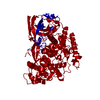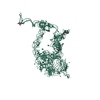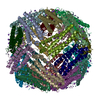+Search query
-Structure paper
| Title | Polyelectrolyte coating of cryo-EM grids improves lateral distribution and prevents aggregation of macromolecules. |
|---|---|
| Journal, issue, pages | Acta Crystallogr D Struct Biol, Vol. 78, Issue Pt 11, Page 1337-1346, Year 2022 |
| Publish date | Nov 1, 2022 |
 Authors Authors | Dominik Hrebík / Mária Gondová / Lucie Valentová / Tibor Füzik / Antonín Přidal / Jiří Nováček / Pavel Plevka /  |
| PubMed Abstract | Cryo-electron microscopy (cryo-EM) is one of the primary methods used to determine the structures of macromolecules and their complexes. With the increased availability of cryo-electron microscopes, ...Cryo-electron microscopy (cryo-EM) is one of the primary methods used to determine the structures of macromolecules and their complexes. With the increased availability of cryo-electron microscopes, the preparation of high-quality samples has become a bottleneck in the cryo-EM structure-determination pipeline. Macromolecules can be damaged during the purification or preparation of vitrified samples for cryo-EM, making them prone to binding to the grid support, to aggregation or to the adoption of preferential orientations at the air-water interface. Here, it is shown that coating cryo-EM grids with a negatively charged polyelectrolyte, such as single-stranded DNA, before applying the sample reduces the aggregation of macromolecules and improves their distribution. The single-stranded DNA-coated grids enabled the determination of high-resolution structures from samples that aggregated on conventional grids. The polyelectrolyte coating reduces the diffusion of macromolecules and thus may limit the negative effects of the contact of macromolecules with the grid support and blotting paper, as well as of the shear forces on macromolecules during grid blotting. Coating grids with polyelectrolytes can readily be employed in any laboratory dealing with cryo-EM sample preparation, since it is fast, simple, inexpensive and does not require specialized equipment. |
 External links External links |  Acta Crystallogr D Struct Biol / Acta Crystallogr D Struct Biol /  PubMed:36322417 / PubMed:36322417 /  PubMed Central PubMed Central |
| Methods | EM (single particle) |
| Resolution | 1.77 - 3.8 Å |
| Structure data | EMDB-14679, PDB-7ze1:  EMDB-14680: Tribolium castaneum hexamerin 2 from aggregated sample EMDB-14704, PDB-7zfw: EMDB-14705, PDB-7zg7: |
| Chemicals |  ChemComp-ZN:  ChemComp-NA:  ChemComp-HOH: |
| Source |
|
 Keywords Keywords | UNKNOWN FUNCTION / hexamerin / tribolium castaneum /  storage protein / storage protein /  RIBOSOME / RIBOSOME /  human 80S ribosome / ssDNA covered grid / human 80S ribosome / ssDNA covered grid /  ssDNA / ssDNA /  cryoEM / METAL BINDING PROTEIN / cryoEM / METAL BINDING PROTEIN /  apoferritin apoferritin |
 Movie
Movie Controller
Controller Structure viewers
Structure viewers About Yorodumi Papers
About Yorodumi Papers











